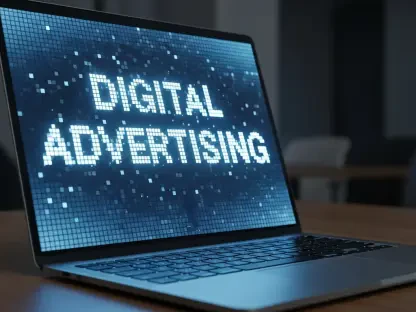The Current Landscape of Marketing Automation and AI Integration
Imagine a marketing world where campaigns are launched with pinpoint accuracy, achieving conversion rates that were once thought impossible, and generating daily revenues that transform businesses overnight. This is no longer a distant dream but the reality of today’s marketing automation landscape, heavily fueled by artificial intelligence (AI). The industry has evolved dramatically over recent years, moving from manual processes to sophisticated systems where AI drives efficiency and results. Marketing automation now integrates advanced technologies to handle complex tasks, enabling businesses to scale operations with unprecedented speed.
At the heart of this transformation lies AI’s expansive role across various marketing domains. Key areas such as search engine optimization (SEO), content creation, lead generation, and e-commerce email marketing have seen remarkable advancements due to AI tools. Technologies like Large Language Models (LLMs) and automation platforms have become integral, allowing for personalized customer interactions and streamlined workflows. Major players in the tech space are investing heavily in these innovations, while early adopters gain a significant competitive edge by leveraging AI to outpace traditional methods.
This shift holds profound implications for marketing professionals and agencies. The integration of AI is redefining job roles, demanding new skills, and altering client expectations. As the industry pivots toward technology-driven solutions, understanding this landscape becomes crucial for staying relevant. The urgency to adapt is clear, setting the stage for a deeper exploration of how AI is reshaping marketing automation strategies.
Key Trends and Performance Metrics in AI-Driven Marketing
Emerging Trends and Technological Innovations
The marketing automation sector is witnessing a surge in transformative trends, with AI agents and automated workflows leading the charge. These technologies enable marketers to execute campaigns with minimal manual intervention, focusing on strategy rather than repetitive tasks. Data-driven personalization has also emerged as a cornerstone, tailoring customer experiences to individual preferences and boosting engagement. Such advancements are rapidly becoming standard practice across the industry.
Innovative tools are further accelerating this change. Solutions like Replit Agent 3 for autonomous development, parasite SEO techniques for high-impact visibility, and custom ChatGPT prompts for content generation are redefining efficiency. These tools allow marketers to optimize operations at scale, addressing the growing demand for technology-driven solutions. Meanwhile, consumer behaviors are shifting toward expecting highly personalized interactions, pushing businesses to adopt AI to meet these expectations.
The opportunities for marketers are vast in this evolving landscape. Leveraging AI not only enhances client outcomes through better targeting and engagement but also improves operational scalability. By embracing these trends, professionals can position themselves at the forefront of innovation, capitalizing on tools that streamline processes and deliver measurable results in a competitive market.
Performance Data and Growth Projections
Concrete metrics highlight the transformative power of AI in marketing automation. Industry data shows conversion rates soaring from a modest 4% to an impressive 60% through optimized AI workflows. Daily revenues have also seen remarkable growth, often exceeding $1,000 for businesses employing these strategies. Such figures underscore the tangible benefits of integrating AI into marketing efforts, setting a new benchmark for success.
Economic impacts are equally striking when comparing AI-assisted models to traditional approaches. Profit margins for AI-driven systems reach up to 80%, dwarfing the 20% margins typical of conventional agencies. This disparity illustrates a fundamental shift in profitability, making a compelling case for technology adoption. Businesses that harness these capabilities are not only achieving higher returns but also redefining industry standards.
Looking ahead, the trajectory for AI adoption in marketing points to sustained growth. Projections suggest that over the next few years, from 2025 to 2027, the reliance on AI will intensify, with revenue scaling potential continuing to expand. With traditional agency models predicted to become obsolete within a 24-month timeframe, the urgency to transition to AI-driven frameworks is evident, signaling a critical period of adaptation for the sector.
Challenges in Adopting AI for Marketing Automation
Implementing AI strategies in marketing automation is not without hurdles, particularly on the technical front. Complexities arise in configuring systems, requiring expertise in API integrations, webhook setups, and data flow optimization. These technical demands can pose significant barriers for teams unaccustomed to such advanced setups, slowing down the adoption process.
Market-driven challenges further complicate the transition. Resistance from traditional agencies, rooted in established practices, often hinders progress toward embracing AI tools. Additionally, the steep learning curve associated with mastering new technologies can deter professionals who lack prior exposure. This creates a gap between the potential of AI and its practical implementation within many organizations.
Solutions to these challenges are emerging, however. Access to detailed technical guides and automation blueprints offers a pathway to overcoming initial barriers. Balancing AI reliance with human oversight is also critical to ensure strategic alignment and ethical considerations. By addressing these issues systematically, marketers can mitigate risks and facilitate smoother integration of AI into their workflows.
Regulatory and Compliance Considerations in AI Marketing
The regulatory environment surrounding AI in marketing automation presents a complex landscape that businesses must navigate carefully. Data privacy laws are becoming increasingly stringent, demanding strict adherence to protect consumer information. Platform-specific guidelines, such as those governing parasite SEO on sites like Reddit or YouTube, add another layer of compliance requirements that marketers must consider.
Maintaining trust and legality is paramount in this context. Automated outreach and consumer data handling must align with regulatory standards to avoid penalties and reputational damage. Ensuring compliance not only safeguards operations but also builds credibility with clients and audiences who prioritize ethical practices in their interactions with brands.
Security measures are equally vital to protect sensitive client and operational data within AI-driven systems. As automation scales, the risk of data breaches grows, necessitating robust safeguards. Regulatory changes on the horizon could further shape marketing practices, influencing how AI technologies are adopted and implemented. Staying ahead of these shifts is essential for long-term success in the industry.
Future Outlook for AI in Marketing Automation
The future of AI in marketing automation holds immense potential, with advancements in algorithms poised to further disrupt the sector. As tools become more accessible, smaller businesses and independent marketers will likely join the fray, democratizing the benefits of AI. This broadening reach could redefine competitive dynamics, creating a more inclusive landscape for innovation.
Consumer preferences are also evolving, with a growing demand for personalized, data-driven interactions. AI stands ready to meet these expectations by enabling hyper-targeted campaigns and real-time adjustments based on user behavior. This alignment with customer needs will drive further adoption, cementing AI’s role as a fundamental component of marketing strategies.
Growth areas are emerging in the form of new agency models tailored to AI workflows, such as advertising and funnel agencies or specialized content agencies. Global economic conditions, ongoing technological innovation, and the pace of regulatory adaptation will continue to shape this trajectory. Keeping pace with these factors will be crucial for marketers aiming to capitalize on the opportunities that lie ahead.
Conclusion and Strategic Recommendations for Marketers
Reflecting on the profound impact of AI on marketing automation, it is evident that the technology has redefined industry benchmarks with conversion rates reaching 60% and profit margins climbing to 80%. These achievements underscore a seismic shift that has already taken hold, compelling professionals to rethink traditional approaches. The urgency to adapt within a tight 24-month window is a critical takeaway, pushing agencies to prioritize transformation.
Looking ahead, marketers should focus on actionable steps to navigate this landscape. Investing in technical proficiency through training and resources like implementation guides can bridge knowledge gaps. Emphasizing measurable key performance indicators ensures that AI strategies align with business goals, delivering tangible outcomes. Exploring partnerships with tech providers could also accelerate adoption, offering access to cutting-edge tools.
Ultimately, the path forward lies in viewing AI not as a trend but as the new foundation of marketing. Those who embrace this shift stand to unlock vast potential for growth and innovation. By proactively addressing challenges and leveraging available support, marketers can position themselves as leaders in an industry that has been forever changed by technology.









